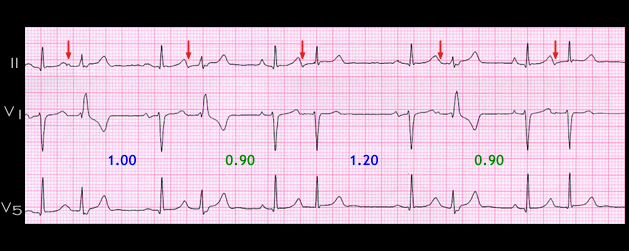
This ECG also demonstrates group beating caused by atrial premature beats occurring in a pattern of bigeminy. In this example, the diagnosis is a bit more difficult because the premature P waves (arrows) fall within the T wave and are less obvious than those shown on the preceding page. The non-uniformity of the QRS complexes that follow the atrial premature beats is due to intermittent aberrant ventricular conduction. This is explained by the subtle differences in the coupling intervals of the premature P waves and the more obvious differences in the duration of the post-extrasystolic pauses. Note that the post-extrasystolic pauses that precede the aberrantly conducted QRS complexes (1.00 and 1.20 seconds) are longer than those that precede the normally conducted premature QRS complexes (0.90 seconds).
